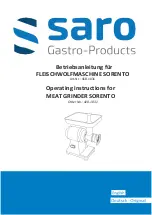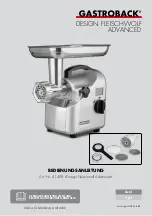
27
EngLIsh
wheel or accessory stops rotating. Make sure the accessory
has come to a complete stop be fore laying the tool down.
Put the work in a vise or clamp it securely. Use a face mask
over the nose and mouth if the operation raises dust. Treat
the wheel with respect. Do not jam the wheel into the work or
use unnecessary pressure. Grind only on the face of the wheel
unless you have a special wheel specifically make to permit
grinding on the side of the wheel.
Slider Switch (Fig. A)
CAUTION:
Hold the neck and body of the tool firmly to
maintain control of the tool at start up and during use and
until the wheel or accessory stops rotating. Make sure the
wheel or accessory has come to a complete stop be fore
laying the tool down.
nOtE:
To reduce unexpected tool movement, do not switch
the tool on or off while under load conditions. Allow the grinder
to run up to full speed before touching the work surface. Lift the
tool from the surface before turning the tool off. Allow the tool
to stop rotating before putting it down.
WARNING:
Before connecting the tool to a power supply,
be sure the slider switch is in the off position by pressing
the rear part of the switch and releasing. Ensure the slider
switch is in the off position as described above after any
interruption in power supply to the tool, such as the
activation of a ground fault interrupter, throwing of a
circuit breaker, accidental unplugging, or power failure. If
the slider switch is locked on when the power is connected,
the tool will start unexpectedly.
To start the tool, slide the ON/OFF slider switch
8
toward
the front of the tool. To stop the tool, release the ON/OFF
slider switch.
For continuous operation, slide the switch toward the front of
the tool and press the forward part of the switch inward. To stop
the tool while operating in continuous mode, press the rear part
of the slider switch and release.
LED Worklight (Fig. A)
CAUTION: Do not stare into worklight.
Serious eye
injury could result.
The worklight
7
located around the collet is activated as soon
as the tool is powered. The worklight will stay illuminated as
long as the tool is powered.
nOtE:
The worklight is for lighting the immediate work surface
and is not intended to be used as a flashlight.
Spindle Lock (Fig. A)
The spindle lock
2
is provided to prevent the spindle from
rotating when installing or removing accessories. Operate the
spindle lock only when the tool is turned off, unplugged from
the power supply, and has come to a complete stop.
NOTICE:
To reduce the risk of damage to the tool, do
not engage the spindle lock while the tool is operating.
Damage to the tool will result and attached accessory
may spin off possibly resulting in injury.
To engage the lock, depress the spindle lock button and
rotate the spindle by hand until you are unable to rotate the
spindle further.
Precautions To Take When Working on a
Painted Workpiece
1. Sanding or wire brushing of lead based paint is NOT
RECOMMENDED due to the difficulty of controlling the
contaminated dust. The greatest danger of lead poisoning is
to children and pregnant women.
2. Since it is difficult to identify whether or not a paint contains
lead without a chemical analysis, we recommend the
following precautions when sanding any paint:
Personal Safety
1. No children or pregnant women should enter the work area
where the paint sanding or wire brushing is being done
until all clean up is completed.
2. A dust mask or respirator should be worn by all persons
entering the work area. The filter should be replaced daily or
whenever the wearer has difficulty breathing.
nOtE:
Only those dust masks suitable for working with lead
paint dust and fumes should be used. Ordinary painting
masks do not offer this protection. See your local hardware
dealer for the proper N.I.O.S.H. approved mask.
3. NO EATING, DRINKING or SMOKING should be done in the
work area to prevent ingesting contaminated paint particles.
Workers should wash and clean up BEFORE eating, drinking
or smoking. Articles of food, drink, or smoking should not be
left in the work area where dust would settle on them.
Environmental Safety
1. Paint should be removed in such a manner as to minimize
the amount of dust generated.
2. Areas where paint removal is occurring should be sealed
with plastic sheeting of 4 mils thickness.
3. Sanding should be done in a manner to reduce tracking of
paint dust outside the work area.
Cleaning and Disposal
1. All surfaces in the work area should be vacuumed and
thoroughly cleaned daily for the duration of the sanding
project. Vacuum filter bags should be changed frequently.
2. Plastic drop cloths should be gathered up and disposed
of along with any dust chips or other removal debris. They
should be placed in sealed refuse receptacles and disposed
of through regular trash pick-up procedures. During clean
up, children and pregnant women should be kept away
from the immediate work area.
3. All toys, washable furniture and utensils used by children
should be washed thoroughly before being used again.
Summary of Contents for DWE4997
Page 1: ...DWE4997 Final page size A5 148mm x 210mm ...
Page 3: ...1 Fig A Fig B 11 12 4 5 2 3 6 1 8 10 9 7 XXXX XX XX 13 ...
Page 4: ...2 Fig D Fig C ...
Page 121: ......
Page 122: ......
Page 123: ......
















































